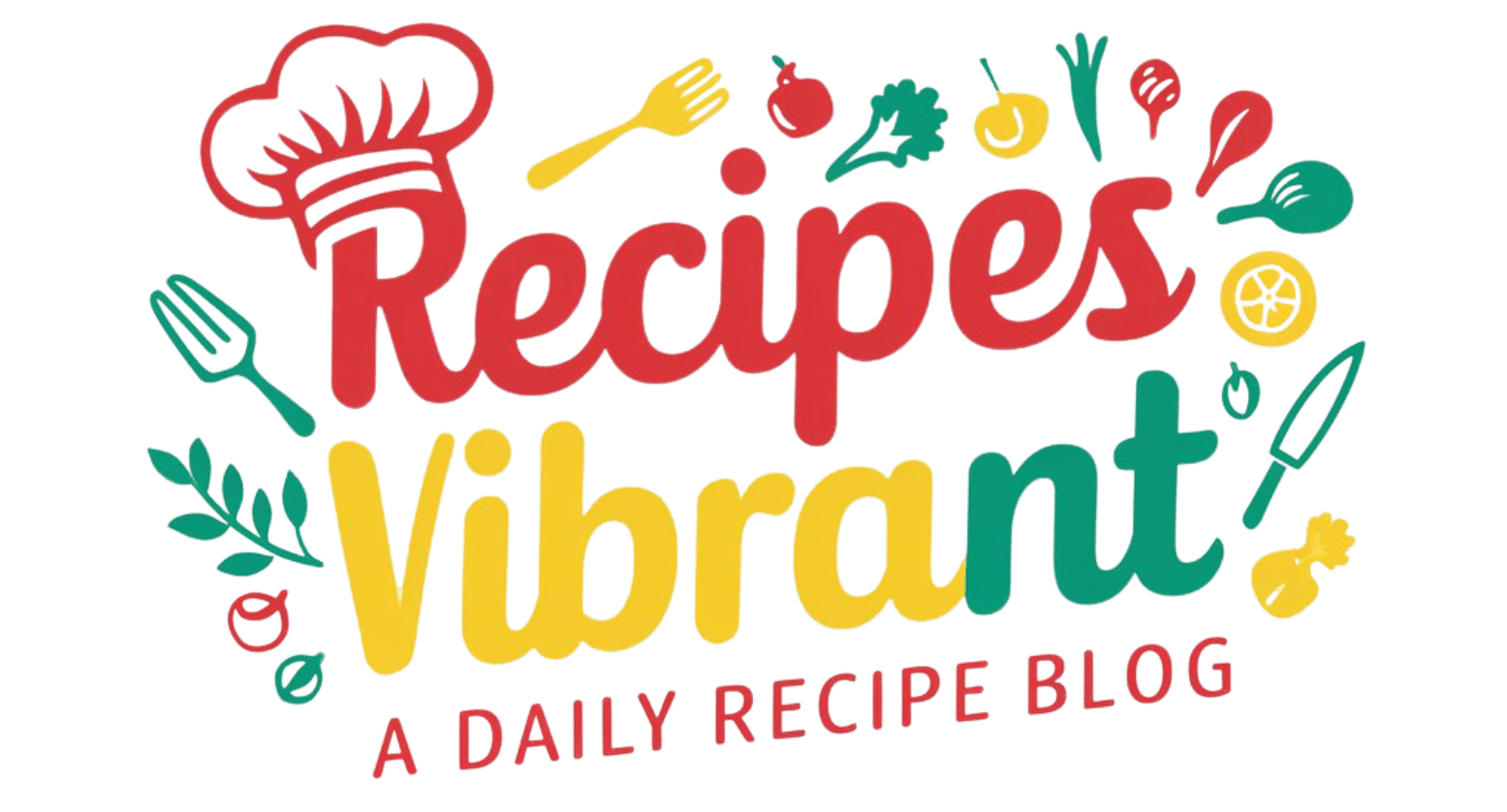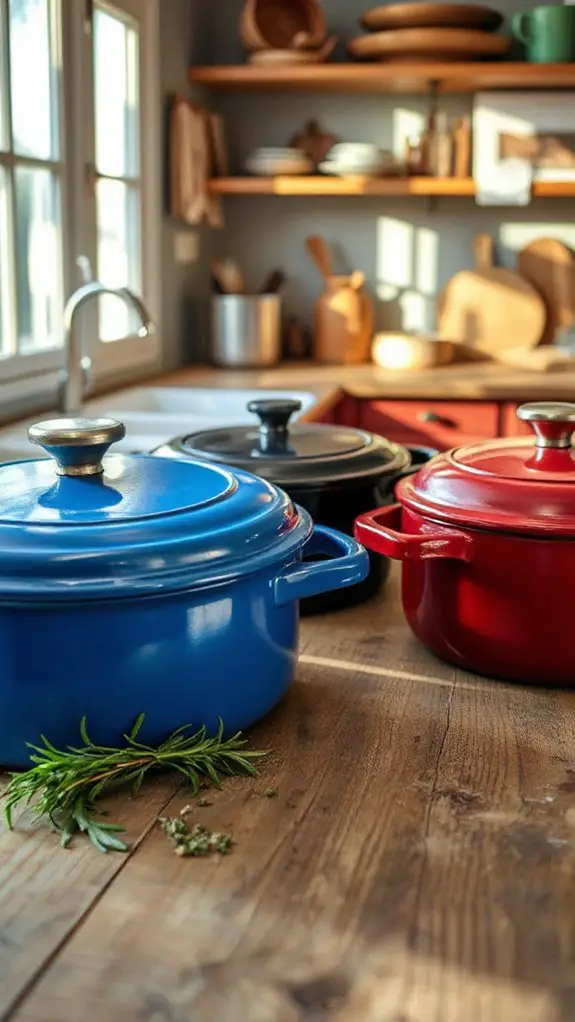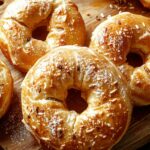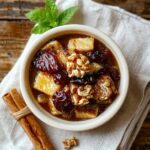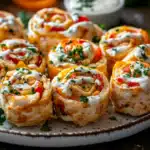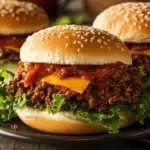When it comes to elevating my cooking in 2025, I’ve found three Dutch ovens that stand out for their performance and style. Whether it’s the Caraway’s sleek nonstick ceramic design, the Overmont’s vibrant enameled finish, or the Amazon Basics’ reliable cast iron build, each brings something unique to the kitchen. But what really sets them apart might surprise you—let’s explore why these picks could transform your culinary game.
Amazon Basics Cast Iron Dutch Oven Pot (4.3-Quart, Red)
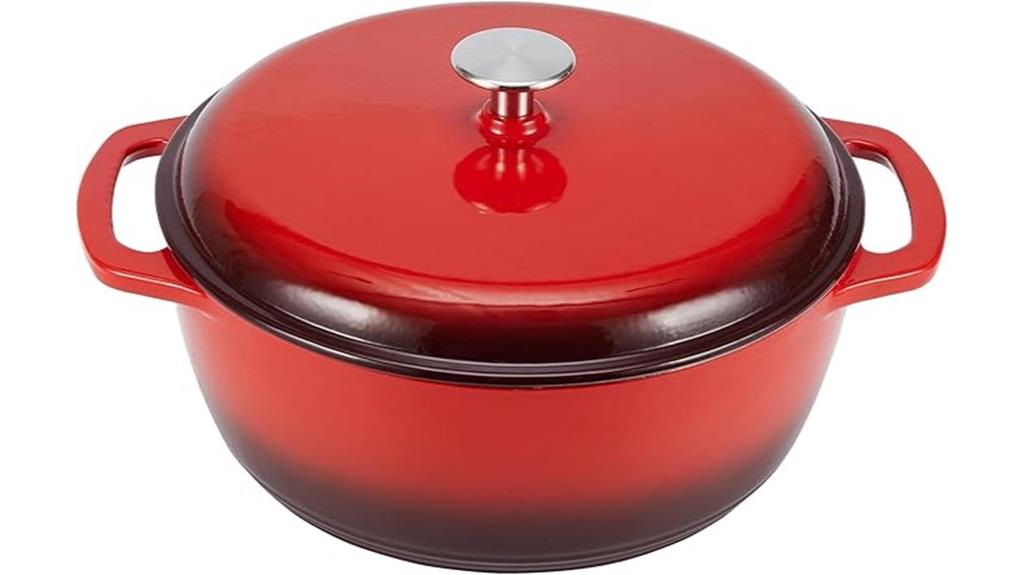
The Amazon Basics Cast Iron Dutch Oven Pot (4.3-Quart, Red) is a fantastic choice for anyone who loves cooking hearty meals without breaking the bank. Its enameled cast iron construction guarantees even heat distribution, making it perfect for soups, stews, and even baking bread. The snug lid locks in moisture, while its 500°F oven-safe rating means it handles roasting with ease. Though heavy at 11.2 pounds, its durability and vibrant red finish add charm to any kitchen. Hand wash only, but cleaning’s a breeze—just avoid metal utensils. With rave reviews and a budget-friendly price, it’s a steal for home cooks.
Best For: Home cooks seeking an affordable, versatile, and durable cast iron Dutch oven for soups, stews, and bread baking.
Pros:
- Excellent heat retention for even cooking and baking.
- Budget-friendly alternative to high-end brands.
- Vibrant red finish adds aesthetic appeal to any kitchen.
Cons:
- Heavy at 11.2 pounds, which may be cumbersome for some users.
- Hand wash only, not dishwasher safe.
- Some users reported minor paint chipping issues.
Caraway Nonstick Ceramic Dutch Oven Pot (6.5 qt, Black)
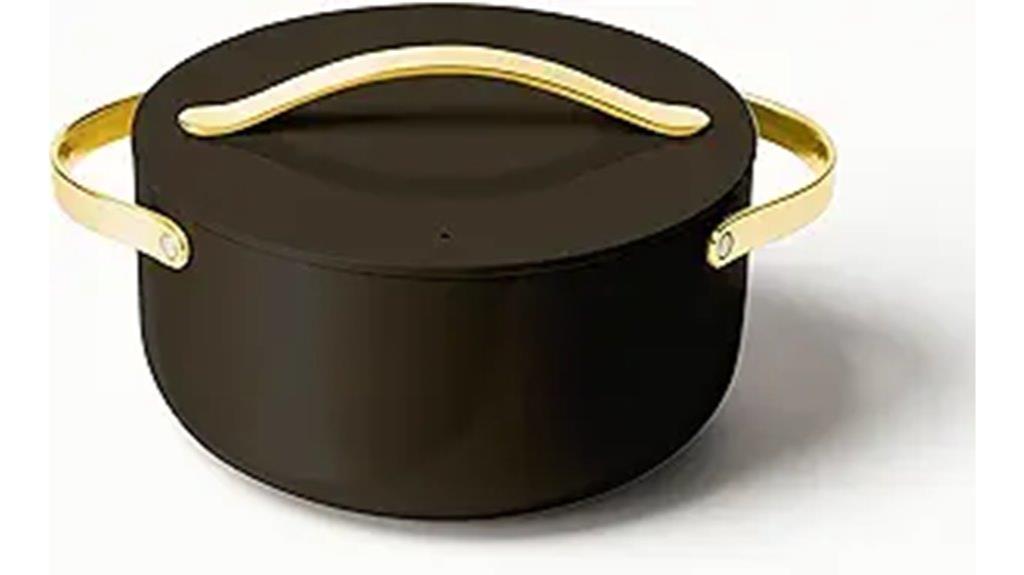
Perfect for anyone who values both style and functionality in their kitchen, the Caraway Nonstick Ceramic Dutch Oven Pot blends practicality with a sleek design that’s as good on the table as it is on the stove. Its 6.5-quart capacity handles everything from hearty stews to fresh-baked bread, while the non-toxic ceramic coating guarantees healthy, flavorful meals. The pot’s non-stick surface makes cleanup a breeze, even after cooking sticky dishes. Oven-safe up to 550°F and compatible with all stovetops, it’s versatile for any cooking method. With its modern black finish and easy-care instructions, this Dutch oven combines beauty and performance for everyday cooking adventures.
Best For: Home cooks who want a stylish, non-toxic, and versatile Dutch oven for healthy and easy cooking.
Pros:
- Non-toxic ceramic coating ensures safe and healthy cooking.
- Versatile use across all stovetops and oven-safe up to 550°F.
- Easy cleanup with naturally non-stick surface and hand wash care.
Cons:
- Hand wash recommended, which may be less convenient for some users.
- Higher price point compared to traditional Dutch ovens.
- Limited color options may not suit all kitchen aesthetics.
Overmont Enameled Cast Iron Dutch Oven with Lid (5.5QT)
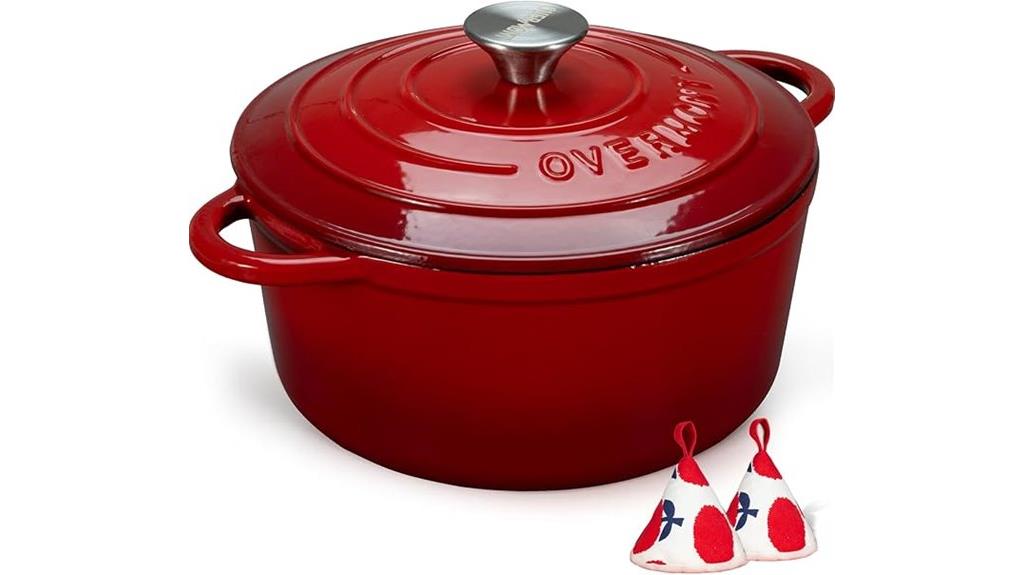
For anyone passionate about creating hearty stews, baking crusty sourdough, or whipping up one-pot wonders, the Overmont 5.5QT Enameled Cast Iron Dutch Oven is a game-changer. Its cherry red finish and gold knob add elegance to any kitchen, while its heavy-duty cast iron guarantees even heat for perfect results. The innovative lid locks in moisture, keeping meals tender and flavorful. It’s versatile, working on gas, electric, and induction stovetops, and safe in ovens up to 500℉. Cleaning’s a breeze with its smooth enamel surface, though it’s not dishwasher safe. Customers rave about its performance and durability, making it a trusty companion for endless culinary adventures.
Best For: Home cooks and culinary enthusiasts looking for a versatile, durable, and stylish Dutch oven for a variety of cooking methods.
Pros:
- Exceptional heat distribution and retention for consistent cooking results.
- Versatile use across multiple stovetops and oven-safe up to 500℉.
- Easy-to-clean smooth enamel surface with elegant design and sturdy construction.
Cons:
- Not dishwasher safe, requiring manual cleaning.
- Heavy at 13.29 pounds, which may be cumbersome for some users.
- Some reports of enamel chipping, though customer service is responsive to concerns.
Factors to Consider When Choosing a Dutch Oven
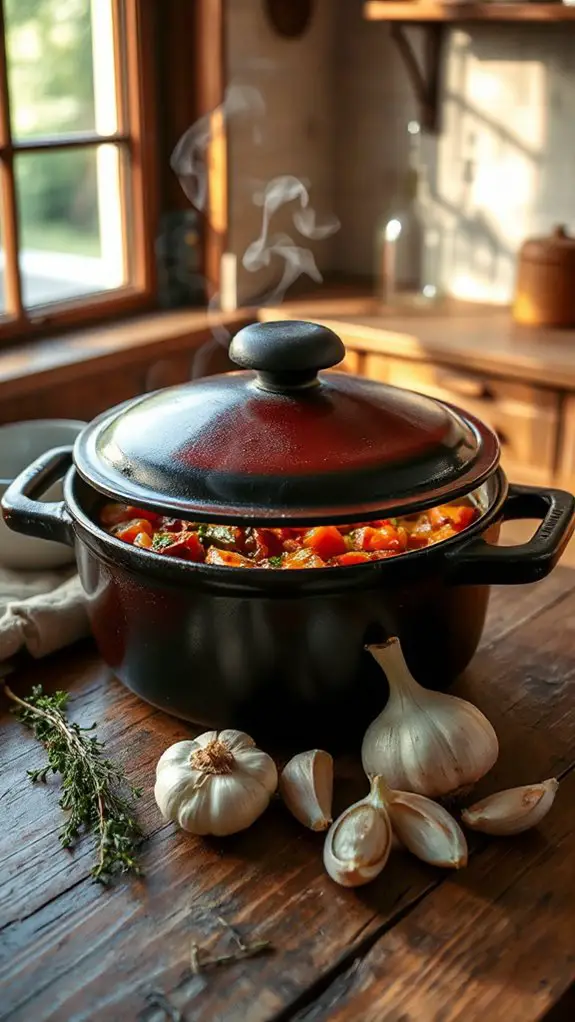
When I pick a Dutch oven, I first think about the material type and how well it holds heat for my favorite recipes. Then, I check the capacity size to make sure it’s big enough for family meals but still easy to handle. Finally, I consider cooking versatility and ease of cleaning because, let’s be honest, nobody wants to spend forever scrubbing pans!
Material Type
Material type can make or break your Dutch oven experience, so it’s worth taking a moment to think about what suits you best. Cast iron is a classic choice, known for its unbeatable heat retention and even cooking. Enameled versions add a sleek, non-reactive coating that’s easy to clean and great for acidic dishes. They’re durable but heavy, so keep that in mind if you’re not a fan of lifting. Ceramic Dutch ovens, on the other hand, are lighter and often come with a naturally non-stick surface, making cleanup a breeze. They’re also free from harmful chemicals, which I love for peace of mind. Heat tolerance matters too—most handle up to 500°F, but check the specifics. Think about your cooking style, and pick what feels right!
Capacity Size
Now that we’ve covered material types, let’s talk about size—because no one wants a Dutch oven that’s too small for their famous chili or so big it barely fits on the stove. When it comes to capacity, think about how many people you’re usually cooking for. A 4.3-quart Dutch oven is perfect for one to three servings, while a 6.5-quart model handles family dinners or bigger dishes like stews and casseroles. I usually cook for four, so a 5.5-quart size works great for me. Larger ovens offer versatility, but they can get heavy, so consider how comfortable you are lifting and moving them. I’ve learned it’s all about finding that sweet spot: enough space for your meals without making your arms ache every time you use it.
Heat Retention
Because heat retention can make or break a dish, it’s one of the most important features to evaluate in a Dutch oven. I’ve learned that cast iron is king when it comes to holding heat, keeping my stews simmering evenly and my breads baking perfectly. Enameled surfaces add durability and improve heat retention, which I’ve found makes cleanup easier without sacrificing performance. A snug-fitting lid is another must—it traps moisture and heat, keeping flavors locked in and ensuring dishes cook evenly. I’ve noticed heavier, thicker Dutch ovens maintain consistent heat better, which is great for slow-cooked meals. When I’m cooking, I rely on my Dutch oven’s ability to hold steady temperatures, and it’s made a world of difference in my dishes. Heat retention isn’t just a feature—it’s essential for cooking success.
Cooking Versatility
When it comes to choosing a Dutch oven, its cooking versatility is what really makes it shine in the kitchen. I love how one pot can handle roasting, baking, and simmering—perfect for everything from crusty bread to hearty stews. Look for one that works on all stovetops, including induction, and is oven-safe, so you’re never limited. A tight-fitting lid locks in moisture, making dishes tender and flavorful. Enameled cast iron is my go-to for even heat, but ceramic nonstick is great for lighter meals. A 5.5- or 6.5-quart size lets you cook for a crowd or just yourself. Trust me, once you start using it, you’ll wonder how you ever cooked without it. It’s like having a kitchen superhero!
Ease of Cleaning
Besides being versatile in the kitchen, a Dutch oven should also be easy to clean—trust me, no one wants to spend more time scrubbing than cooking! When I’m choosing one, I look for features that make cleanup a breeze. Enameled cast iron Dutch ovens usually need hand washing with warm, soapy water to keep their finish intact, but smooth enamel surfaces let food residues wipe away easily. Nonstick ceramic options are even simpler to clean, often needing just a quick rinse. I’ve found that nonstick surfaces also cut down on the oil or butter I need, which means less mess overall. One tip—avoid the dishwasher, as it can damage finishes and cause rust. After washing, I always dry mine thoroughly to keep it in great shape for years to come.
Compatibility
If you’re like me and love cooking, you know that having the right tools can make all the difference. When it comes to Dutch ovens, compatibility is key. I always check if it works with my stovetop—whether it’s gas, electric, ceramic, or induction. Enamel-coated cast iron is a winner here, handling all types seamlessly. Heat tolerance matters, too; most Dutch ovens can withstand 500°F to 550°F, perfect for roasting or baking. Size is another factor; I’ve found 4.3 quarts ideal for smaller meals, while 6.5 quarts suits larger gatherings. Finish plays a role as well—ceramic coatings offer non-stick convenience, while cast iron excels in durability and heat retention. Finally, I confirm it’s easy to care for, with straightforward cleaning and maintenance tips to keep it in top shape. Compatibility guarantees versatility and longevity.
Price Range
Finding the right Dutch oven that fits both your cooking needs and your budget can feel like a balancing act. Dutch ovens come in a wide price range, with budget-friendly options starting at $30-$50, perfect for beginners or casual cooks. If you’re willing to invest a bit more, mid-range models between $100-$200 often offer better heat retention and stylish designs, making them great for regular use. For serious cooks, high-end Dutch ovens—costing over $200—deliver exceptional performance, durability, and craftsmanship. While they’re pricier, they often come with better warranties and customer support, which can save you money in the long run. I’ve found that choosing the right price point depends on how often you’ll use it and the features you value most. Don’t be afraid to splurge if it aligns with your cooking goals!
Frequently Asked Questions
Can Dutch Ovens Be Used on Induction Stoves?
I wonder if Dutch ovens can be used on induction stoves. I’ve found that only Dutch ovens with a magnetic base, like cast iron or some stainless steel ones, work because induction requires magnetic material to heat.
What Is the Best Way to Season a Dutch Oven?
I’ll treat my Dutch oven like nurturing old leather—lightly oiling its surface, baking it slow until it gleams. I’ll repeat this ritual, building layers of protection till it’s ready for endless culinary tales.
Are Dutch Ovens Dishwasher Safe?
I’ve found Dutch ovens aren’t dishwasher safe, as harsh detergents and heat can damage their enamel or seasoning. I always hand-wash mine with warm water and mild soap to keep it in great condition.
How Do I Prevent Food From Sticking in a Dutch Oven?
I always preheat my Dutch oven and add enough oil to coat the bottom before cooking. I avoid stirring too soon—letting food sear first helps. I also keep the heat moderate and don’t overcrowd the pan.
Can Dutch Ovens Be Used in the Oven?
I’ve found that these sturdy pots can handle more than just stovetop cooking—they thrive in the oven’s embrace. Most are oven-safe up to high temperatures, but I always check the manufacturer’s limits to avoid any mishaps.
Conclusion
Cooking creations call for careful choices, and these Dutch ovens deliver. Whether you’re crafting cozy casseroles or baking brilliant bread, each pot pours perfection into your dishes. I’ve found the Caraway’s cleanup a cinch, the Overmont’s hue a head-turner, and the Amazon Basics’ heat-holding a hero. Picking the perfect pot hinges on your needs—size, style, and simplicity. Trust me, with these treasures, your kitchen victories will be vibrant, versatile, and downright delicious. Happy cooking!
